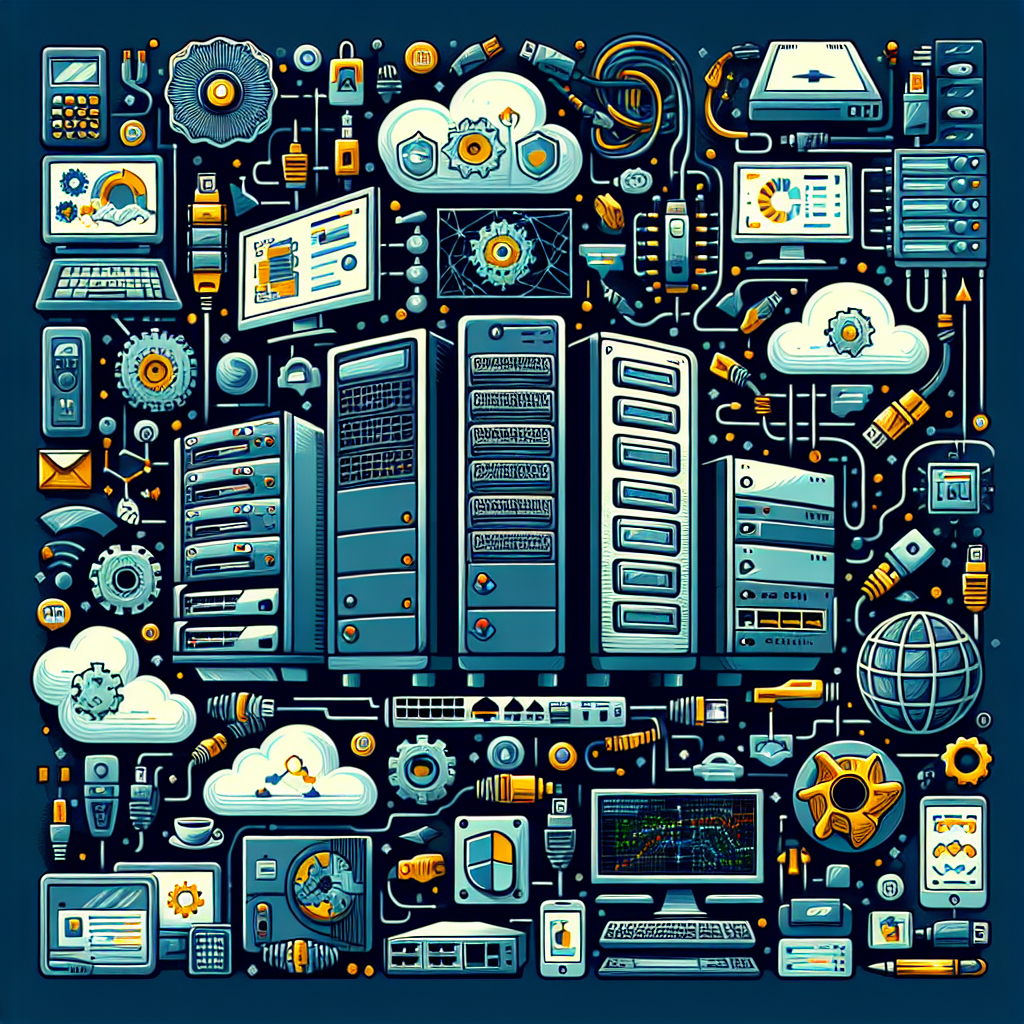Your cart is currently empty!
Tag: Top

Top Tools and Technologies for Streamlining Network Management
In today’s digital age, network management is more important than ever for businesses to ensure seamless connectivity and smooth operations. With the increasing complexity of networks and the ever-growing demand for faster and more reliable connections, it has become essential for organizations to leverage top tools and technologies to streamline their network management processes.Here are some of the top tools and technologies that are revolutionizing network management:
1. Network Monitoring Tools: Network monitoring tools are essential for keeping track of the performance and health of your network infrastructure. These tools provide real-time insights into network traffic, bandwidth usage, and device performance, allowing IT teams to quickly identify and address any issues that may arise.
2. Network Configuration Management Tools: Network configuration management tools help IT teams streamline the process of configuring and managing network devices. These tools automate the configuration process, reducing the risk of human error and ensuring consistency across the network.
3. Software-Defined Networking (SDN): SDN is a revolutionary technology that allows organizations to centrally manage and control their network infrastructure through software. SDN enables greater flexibility, scalability, and automation, making it easier to adapt to changing business needs and optimize network performance.
4. Network Automation Tools: Network automation tools automate manual network management tasks, such as device provisioning, configuration changes, and troubleshooting. By automating repetitive tasks, IT teams can save time and resources, allowing them to focus on more strategic initiatives.
5. Artificial Intelligence (AI) and Machine Learning: AI and machine learning are transforming network management by providing predictive analytics and insights into network performance. These technologies can identify patterns and anomalies in network data, enabling IT teams to proactively address issues before they impact operations.
6. Cloud-Based Network Management Platforms: Cloud-based network management platforms provide a centralized solution for managing and monitoring network infrastructure across multiple locations. These platforms offer scalability, flexibility, and accessibility, allowing organizations to easily manage their networks from anywhere, at any time.
7. Network Security Tools: Network security is a top priority for organizations, and network security tools help protect against cyber threats and vulnerabilities. These tools include firewalls, intrusion detection systems, and encryption technologies to safeguard sensitive data and prevent unauthorized access.
By leveraging these top tools and technologies, organizations can streamline their network management processes, improve efficiency, and enhance overall network performance. With the increasing complexity of networks and the growing demand for faster, more reliable connections, investing in these tools is essential for staying ahead in today’s competitive business landscape.

Proactive Maintenance Tips for Keeping Your Facility in Top Shape
Proactive Maintenance Tips for Keeping Your Facility in Top ShapeMaintaining a facility is crucial for ensuring that everything runs smoothly and efficiently. By being proactive with maintenance, you can prevent costly repairs and downtime while also prolonging the lifespan of your equipment and infrastructure. Here are some tips for keeping your facility in top shape:
1. Create a Maintenance Schedule: One of the best ways to stay on top of maintenance tasks is to create a schedule outlining when specific tasks need to be completed. This can include daily, weekly, monthly, and annual tasks such as equipment inspections, cleaning, and preventative maintenance.
2. Conduct Regular Inspections: Regular inspections can help you identify potential issues before they become major problems. Inspect equipment, systems, and infrastructure regularly to catch any issues early on and address them promptly.
3. Train Staff on Maintenance Procedures: Make sure your staff is trained on how to properly maintain equipment and systems within your facility. This can help prevent accidents and costly mistakes while ensuring that maintenance tasks are completed correctly.
4. Keep Detailed Maintenance Records: Keeping detailed records of maintenance tasks and repairs can help you track the history of your equipment and identify trends or recurring issues. This can also help you stay on top of maintenance schedules and ensure that tasks are completed in a timely manner.
5. Invest in Preventative Maintenance: Investing in preventative maintenance can help you avoid costly repairs and downtime by addressing issues before they escalate. Regularly servicing equipment and systems can help prolong their lifespan and ensure they are operating at peak efficiency.
6. Address Issues Promptly: If you notice any issues or problems within your facility, address them promptly to prevent them from worsening. Ignoring issues can lead to more extensive damage and costly repairs down the line.
7. Stay Informed: Stay informed about industry best practices and new technologies that can help improve maintenance efficiency and effectiveness. By staying up-to-date on the latest trends and advancements, you can ensure that your facility is operating at its best.
By following these proactive maintenance tips, you can keep your facility in top shape and prevent costly repairs and downtime. Investing time and resources into maintenance now can help you save money and avoid headaches in the long run. Remember, maintenance is an ongoing process, so staying proactive is key to ensuring the success of your facility.
Top 5 Cryptocurrencies to Invest in This Month
Bitcoin has been unable to sustain its strength in the past 24 hours, fueled by a crash in the US stock market. At press time, Bitcoin trades at $100,400, down 4.37% today.
As Bitcoin falls, traders often look to alternative new opportunities that could provide strong gains when prices recover.
With that in mind, here are our five picks of the best crypto to buy now.
Wall Street Pepe
One of the best things to look for when identifying cryptocurrencies with potential is momentum, and Wall Street Pepe has it in spades.
The project – which adds utility to the Pepe the Frog brand – is showing massive growth in its token presale. In under eight weeks, it has raised $60 million, which works out at $7.5 million per week.
What’s more, this is happening while the broader market struggles. This means traders are rotating capital from other altcoins to $WEPE, underlining its strong appeal.
Wall Street Pepe is a meme coin with a twist: it offers a trading insights ecosystem. Trading signals, meme coin picks, a trading insider group, staking, and trading rewards are all available.
This means that not only does $WEPE benefit from speculative demand but also utility-driven demand as well.
Visit Wall Street Pepe Presale
MIND Of Pepe
Besides providing innovative utility, Wall Street Pepe is performing so well because it uses Pepe coin’s star power. MIND Of Pepe follows the same playbook.
However, MIND Of Pepe also taps into the prevalent AI trend, which is only growing stronger after President Trump announced a $500 billion venture that will take place over the next four years.
MIND Of Pepe is a new blockchain-based AI agent with its own token, $MIND. The agent autonomously operates both an X account and a crypto wallet, meaning it can simultaneously engage in the social and financial spheres.
On X, MIND Of Pepe will post tweets and engage with others, aiming to gather data, shape narratives, and build an audience.
Then, using its crypto wallet, MIND Of Pepe can launch its own tokens and interact with blockchain dApps, all of which work towards the betterment of its holders.
MIND Of Pepe holders will receive exclusive trend analysis and early access to token launches before anyone else.
The project has raised $3.9 million so far.
Meme Index
Meme Index is a new platform that lets users invest in diversified baskets of meme coins on-chain. Currently, a couple of centralized exchanges, including Bitpanda and Swissborg, offer meme coin baskets, but they only offer one each. Meme Index offers four.
What’s the benefit of meme coin baskets? They create a fast, hassle-free way to get diversified meme coin exposure, which offsets some of the volatility risk.
Meme Indexes baskets are grouped by volatility, ranging from low to ultra-high. This ensures there is something for everyone.
Another benefit of Meme Index is that because it is on-chain, anyone can access the platform without KYC and geo-restriction, which opens the meme coin sector to more people.
The $MEMEX token is required to access the platform, and it’s currently available to buy via a presale. So far, the presale has raised $2.9 million.
Solaxy
Look back to 2024, and you’ll see that Solana dominated other smart contract-enabled blockchains in terms of price performance and adoption.
Look to recent events in 2025 – such as Trump launching his meme coin there and AI frontrunner Virtuals Protocol migrating there – and it becomes clear that Solana remains very bullish.
However, one issue that Solana can’t escape is congestion. While adoption grows, the network’s ability to handle new users stays flat. As we saw when $TRUMP launched, many transactions fail on Solana during times of peak activity. Solaxy is fixing this with the first-ever Solana layer 2 blockchain.
Solaxy is a totally separate network connected to Solana via a bridge. It processes transactions in bundles and reports back to Solana for finality. Solaxy will be faster, cheaper, and more reliable than the Solana layer 1.
The $SOLX token is available for purchase via a presale, which has raised $15 million so far.
Best Wallet Token
Best Wallet is a crypto wallet that addresses the poor on-chain user experience issue.
Right now, investors can capitalize via the Best Wallet token, which is undergoing a presale.
Best Wallet is a new crypto wallet that provides all the features needed so that users can meet their blockchain needs without connecting to external apps.
This includes a decentralized exchange, derivatives trading, a presale aggregator, a crypto debit card, an NFT gallery, a staking aggregator, and more.
It essentially ties the blockchain together inside one unified app. This is more like the user experience of a top centralized exchange than the fragmented and overly complex user experience of an older crypto wallet.
The Best Wallet token lets users get the most out of the app. Holders get trading fee discounts, higher staking yields, governance rights, and access to promotions of partner projects. The token presale has raised $8.3 million so far.
Visit Best Wallet Token Presale
- Bitcoin (BTC) – As the first and most well-known cryptocurrency, Bitcoin continues to be a top choice for investors. With its limited supply and growing adoption by mainstream institutions, Bitcoin is seen as a safe bet for long-term investment.
- Ethereum (ETH) – Ethereum is a decentralized platform that enables smart contracts and decentralized applications to be built and operated without any downtime, fraud, control, or interference. With the upcoming Ethereum 2.0 upgrade and the growing popularity of decentralized finance (DeFi) applications, Ethereum is a strong contender for investment.
- Cardano (ADA) – Cardano is a blockchain platform that aims to provide a more secure and scalable infrastructure for the development of decentralized applications and smart contracts. With a strong community and ongoing development, Cardano has the potential for significant growth in the coming months.
- Binance Coin (BNB) – Binance Coin is the native cryptocurrency of the Binance exchange, one of the largest and most popular cryptocurrency exchanges in the world. With a wide range of use cases within the Binance ecosystem, BNB has shown strong performance and potential for further growth.
- Solana (SOL) – Solana is a high-performance blockchain platform that aims to provide fast and secure decentralized applications. With low transaction fees and high throughput, Solana has gained popularity among developers and investors. As the demand for scalable blockchain solutions continues to grow, Solana could be a promising investment opportunity.
Tags:
- Cryptocurrency investments
- Top 5 cryptocurrencies
- Best cryptocurrency investments
- Cryptocurrency market trends
- Investing in digital currencies
#Top #Cryptocurrencies #Invest #Month

The Top Help Desk Software Solutions for Your Business
In today’s fast-paced business environment, it’s crucial for companies to have effective help desk software solutions in place to support their customers and employees. Help desk software allows businesses to streamline their customer support processes, improve response times, and enhance overall customer satisfaction.With so many help desk software options available in the market, it can be overwhelming to choose the right solution for your business. To help you make an informed decision, we’ve compiled a list of the top help desk software solutions that are trusted by businesses of all sizes.
1. Zendesk: Zendesk is a popular help desk software solution that offers a wide range of features, including ticket management, live chat support, and knowledge base management. With Zendesk, businesses can easily track customer issues, prioritize tasks, and collaborate with team members to resolve problems quickly and efficiently.
2. Freshdesk: Freshdesk is another leading help desk software solution that is known for its user-friendly interface and robust features. With Freshdesk, businesses can automate ticket routing, set up SLA policies, and analyze customer feedback to improve their support processes. Freshdesk also offers integration with popular third-party tools, such as CRM systems and social media platforms.
3. Intercom: Intercom is a customer messaging platform that offers a help desk software solution to support businesses in managing customer inquiries across multiple channels, including email, chat, and social media. With Intercom, businesses can create personalized responses, track customer interactions, and provide proactive support to their customers.
4. Jira Service Management: Jira Service Management is a help desk software solution that is designed for IT teams to manage incidents, problems, and changes effectively. With Jira Service Management, businesses can centralize their IT support operations, automate repetitive tasks, and improve collaboration between different teams within the organization.
5. HubSpot Service Hub: HubSpot Service Hub is a comprehensive help desk software solution that is part of the popular HubSpot CRM platform. With HubSpot Service Hub, businesses can manage customer inquiries, create knowledge base articles, and track customer satisfaction metrics. HubSpot Service Hub also offers integration with other HubSpot tools, such as marketing automation and sales CRM.
In conclusion, investing in a reliable help desk software solution is essential for businesses to deliver exceptional customer support and streamline their internal operations. The top help desk software solutions mentioned above offer a range of features and benefits to help businesses of all sizes improve their support processes and enhance customer satisfaction. Consider evaluating these solutions to find the one that best fits your business needs and budget.

Top Tools and Technologies for Efficient Network Management
In today’s digital age, network management is crucial for businesses to ensure a smooth and efficient operation of their IT infrastructure. With the increasing complexity of networks, it is essential for organizations to have the right tools and technologies in place to effectively manage their networks.Here are some of the top tools and technologies that can help businesses achieve efficient network management:
1. Network monitoring tools: Network monitoring tools help organizations track the performance and availability of their network infrastructure in real-time. These tools provide insights into network traffic, bandwidth usage, and device performance, allowing IT teams to quickly identify and address any issues that may arise.
2. Network configuration management tools: Network configuration management tools help organizations automate the process of configuring and managing network devices such as routers, switches, and firewalls. These tools help streamline network configuration tasks, reduce errors, and ensure consistency across the network.
3. Network performance management tools: Network performance management tools help organizations optimize the performance of their network infrastructure by monitoring key performance indicators such as latency, packet loss, and throughput. These tools help IT teams identify performance bottlenecks and optimize network resources to improve overall network performance.
4. Network security tools: Network security tools help organizations protect their network infrastructure from cyber threats and attacks. These tools include firewalls, intrusion detection systems, and antivirus software, which help prevent unauthorized access, malware infections, and data breaches.
5. Software-defined networking (SDN): SDN is a technology that allows organizations to centrally manage and control their network infrastructure through software-based controllers. SDN enables organizations to automate network configuration, optimize traffic routing, and improve network scalability and flexibility.
6. Network automation tools: Network automation tools help organizations automate repetitive network management tasks, such as configuration changes, software updates, and network provisioning. By automating these tasks, organizations can reduce manual errors, improve efficiency, and free up IT resources for more strategic initiatives.
7. Cloud-based network management platforms: Cloud-based network management platforms offer organizations a centralized and scalable solution for managing their network infrastructure. These platforms provide visibility and control over the entire network, regardless of its size or complexity, and enable organizations to manage their networks from anywhere, at any time.
In conclusion, efficient network management is essential for businesses to ensure the reliability, performance, and security of their IT infrastructure. By leveraging the right tools and technologies, organizations can streamline network management tasks, improve operational efficiency, and better meet the demands of today’s digital business environment.

Top Considerations for Outsourcing Managed Services
Outsourcing managed services has become a popular trend among businesses looking to streamline their operations and reduce costs. By entrusting certain tasks to a third-party provider, companies can focus on their core competencies and achieve greater efficiency in their day-to-day operations. However, before making the decision to outsource managed services, there are several key considerations that businesses should take into account.1. Define your goals and objectives: Before outsourcing any managed services, it is important to clearly define your goals and objectives. What are you looking to achieve by outsourcing these services? Are you looking to reduce costs, improve efficiency, or enhance the quality of your services? By clearly outlining your goals and objectives, you can better evaluate potential service providers and ensure that they align with your business objectives.
2. Evaluate the expertise and experience of the service provider: When outsourcing managed services, it is crucial to assess the expertise and experience of the service provider. Look for a provider that has a proven track record of delivering high-quality services and has experience working with companies similar to yours. Ask for references and case studies to ensure that the provider has the necessary expertise to meet your specific needs.
3. Consider the scalability of the services: When outsourcing managed services, it is important to consider the scalability of the services provided. Can the service provider accommodate your business growth and evolving needs? Ensure that the provider has the flexibility to scale their services as your business expands and changes over time.
4. Evaluate the security and compliance measures: When outsourcing managed services, it is essential to consider the security and compliance measures implemented by the service provider. Ensure that the provider follows industry best practices and complies with relevant regulations and standards. This is especially important if you are outsourcing sensitive data or information.
5. Assess the cost and pricing structure: Cost is a significant factor to consider when outsourcing managed services. Evaluate the pricing structure of the service provider and compare it with other providers in the market. Consider not only the upfront costs but also any potential hidden fees or additional charges that may arise. Ensure that the pricing structure is transparent and aligns with your budget requirements.
6. Evaluate the communication and support capabilities: Effective communication and support are essential when outsourcing managed services. Ensure that the service provider has robust communication channels in place and provides timely support when needed. Look for a provider that offers a dedicated account manager or support team to address any issues or concerns that may arise.
In conclusion, outsourcing managed services can offer numerous benefits to businesses, including cost savings, improved efficiency, and enhanced quality of services. By considering the above factors before outsourcing managed services, businesses can make informed decisions and select the right service provider that aligns with their goals and objectives.

The Top Data Backup and Recovery Solutions for Small Businesses
Data backup and recovery is a critical aspect of running a successful small business. Whether it’s due to a hardware failure, human error, or a cyber-attack, losing important data can be devastating for a company. That’s why it’s essential for small businesses to have a reliable data backup and recovery solution in place.Here are some of the top data backup and recovery solutions that small businesses can consider:
1. Cloud Backup Services:
Cloud backup services like Dropbox, Google Drive, and OneDrive offer small businesses an easy and affordable way to back up their data. These services automatically sync files to the cloud, ensuring that data is always accessible and secure. Additionally, cloud backup services offer features like file versioning and encryption, providing an extra layer of protection for sensitive information.
2. External Hard Drives:
External hard drives are a popular backup solution for small businesses due to their affordability and ease of use. By connecting an external hard drive to a computer, businesses can quickly back up important files and folders. However, it’s important to remember that external hard drives can fail, so it’s essential to have multiple backups in place.
3. Network-Attached Storage (NAS):
NAS devices are a great option for small businesses that require a more robust backup solution. These devices connect to a network and allow multiple users to access and back up data. NAS devices offer features like RAID (redundant array of independent disks) for data protection and remote access capabilities for added convenience.
4. Backup Software:
Backup software like Acronis, Carbonite, and Backblaze offer small businesses a comprehensive backup solution. These tools allow businesses to schedule automatic backups, perform full system backups, and easily recover data in the event of a disaster. Backup software also often includes features like encryption and compression to help protect and optimize data storage.
5. Disaster Recovery Services:
For small businesses that require a more comprehensive backup and recovery solution, disaster recovery services like Datto and Zerto offer peace of mind. These services provide real-time data replication, failover capabilities, and rapid recovery options in the event of a disaster. While these services may be more costly, they provide an extra layer of protection for businesses that cannot afford to lose critical data.
In conclusion, data backup and recovery are essential for the success of any small business. By investing in a reliable backup solution, businesses can protect their data and minimize the risk of downtime in the event of a disaster. Whether it’s through cloud backup services, external hard drives, NAS devices, backup software, or disaster recovery services, small businesses have a variety of options to choose from to ensure their data is safe and secure.

Top Considerations for Outsourcing IT Services
Outsourcing IT services has become a popular choice for businesses looking to streamline their operations and focus on core business activities. By outsourcing IT services, businesses can access specialized expertise, reduce costs, and improve efficiency. However, before making the decision to outsource IT services, there are several key considerations that businesses should keep in mind.1. Define your IT needs: Before outsourcing IT services, it is important to clearly define your organization’s IT needs and objectives. This will help you identify the specific services that you require and ensure that the outsourcing provider can meet your requirements.
2. Research potential outsourcing providers: When selecting an outsourcing provider, it is important to conduct thorough research and due diligence. Look for providers with a proven track record of delivering high-quality IT services and consider their experience, expertise, and reputation in the industry.
3. Consider the cost: Cost is a major consideration when outsourcing IT services. It is important to compare pricing and service offerings from different providers to ensure that you are getting the best value for your money. Remember to consider both the upfront costs and ongoing expenses associated with outsourcing IT services.
4. Evaluate security measures: Data security is a top concern for businesses when outsourcing IT services. It is important to ensure that the outsourcing provider has robust security measures in place to protect your sensitive data and confidential information. Ask about their data encryption protocols, access controls, and disaster recovery plans.
5. Assess scalability and flexibility: As your business grows, your IT needs will also evolve. It is important to choose an outsourcing provider that can scale their services to meet your changing requirements. Look for providers that offer flexible service options and can accommodate your business growth.
6. Communication and support: Effective communication is essential when outsourcing IT services. Make sure that the outsourcing provider has clear communication channels in place and provides timely updates on the status of your IT projects. Additionally, consider the level of support that the provider offers and ensure that they have a responsive support team in place to address any issues or concerns.
7. Review service level agreements (SLAs): Before finalizing an outsourcing agreement, carefully review the service level agreements (SLAs) that outline the scope of services, performance metrics, and responsibilities of both parties. Make sure that the SLAs are clear, concise, and align with your business objectives.
By keeping these top considerations in mind, businesses can make informed decisions when outsourcing IT services. Outsourcing IT services can be a strategic move to improve efficiency, reduce costs, and access specialized expertise. However, it is important to carefully evaluate potential providers, define your IT needs, and ensure that the outsourcing arrangement aligns with your business goals.

The Top Managed Service Providers of 2021: A Comprehensive Review
In today’s fast-paced and complex business landscape, companies are turning to managed service providers (MSPs) to handle their IT needs and help them stay ahead of the competition. With the increasing reliance on technology, it’s crucial for businesses to have a reliable and efficient IT infrastructure in place to support their operations.In this article, we will take a comprehensive look at the top managed service providers of 2021. These companies have been recognized for their exceptional services, expertise, and commitment to helping businesses achieve their IT goals.
1. Accenture
Accenture is a global leader in technology consulting and managed services. With a team of experienced professionals and a wide range of services, Accenture helps businesses optimize their IT infrastructure, improve operational efficiency, and drive innovation. Their services include cloud computing, cybersecurity, data analytics, and digital transformation.
2. IBM
IBM is a well-known name in the IT industry, and for good reason. The company offers a comprehensive suite of managed services, including infrastructure management, cloud computing, cybersecurity, and data analytics. IBM’s team of experts works closely with clients to develop customized solutions that meet their specific needs and help them achieve their business objectives.
3. Deloitte
Deloitte is another top managed service provider that offers a range of services to help businesses navigate the complexities of the digital world. From IT consulting and strategy to cybersecurity and cloud computing, Deloitte has the expertise and experience to help businesses stay ahead of the competition. Their team of professionals works closely with clients to understand their unique challenges and develop tailored solutions to address them.
4. HCL Technologies
HCL Technologies is a global IT services company that offers a wide range of managed services to help businesses streamline their operations and drive growth. With expertise in cloud computing, cybersecurity, data analytics, and digital transformation, HCL Technologies helps businesses leverage technology to achieve their business goals. Their team of experts works closely with clients to develop customized solutions that meet their specific needs and deliver tangible results.
5. Cognizant
Cognizant is a leading managed service provider that helps businesses harness the power of technology to drive innovation and growth. With a focus on digital transformation, cybersecurity, and cloud computing, Cognizant offers a range of services to help businesses stay ahead of the competition. Their team of experts works closely with clients to develop customized solutions that address their unique challenges and help them achieve their business objectives.
In conclusion, the top managed service providers of 2021 are leading the way in helping businesses navigate the complexities of the digital world and achieve their IT goals. From technology consulting and strategy to cybersecurity and cloud computing, these companies offer a wide range of services to help businesses stay ahead of the competition and drive growth. If you are looking for a reliable and efficient managed service provider to support your business, consider one of the providers mentioned above.

